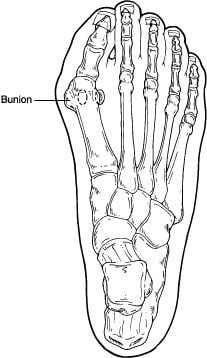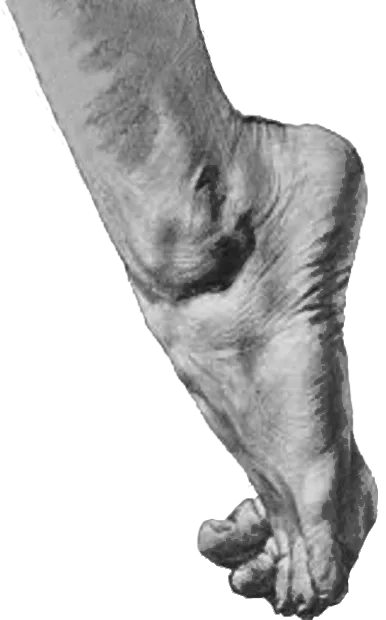Even though bunions are a common foot deformity, there are misconceptions about them. Many people may unnecessarily suffer the pain of bunions for years before seeking treatment.
What is a Bunion?
A bunion (also referred to as hallux valgus or hallux abducto valgus) is often described as a bump on the side of the big toe. But a bunion is more than that. The visible bump actually reflects changes in the bony framework of the front part of the foot. The big toe leans toward the second toe, rather than pointing straight ahead. This throws the bones out of alignment – producing the bunion’s “bump.”
Bunions are a progressive disorder. They begin with a leaning of the big toe, gradually changing the angle of the bones over the years and slowly producing the characteristic bump, which becomes increasingly prominent. Symptoms usually appear at later stages, although some people never have symptoms.
Causes
Bunions are most often caused by an inherited faulty mechanical structure of the foot. It is not the bunion itself that is inherited, but certain foot types that make a person prone to developing a bunion.
Although wearing shoes that crowd the toes won’t actually cause bunions, it sometimes makes the deformity get progressively worse. Symptoms may therefore appear sooner.
Symptoms
Symptoms, which occur at the site of the bunion, may include:
- Pain or soreness
- Inflammation and redness
- A burning sensation
- Possible numbness
Symptoms occur most often when wearing shoes that crowd the toes, such as shoes with a tight toe box or high heels. This may explain why women are more likely to have symptoms than men. In addition, spending long periods of time on your feet can aggravate the symptoms of bunions.

Diagnosis
Bunions are readily apparent – the prominence is visible at the base of the big toe or side of the foot. However, to fully evaluate the condition, the foot and ankle surgeon may take x-rays to determine the degree of the deformity and assess the changes that have occurred.
Because bunions are progressive, they don’t go away, and will usually get worse over time. But not all cases are alike – some bunions progress more rapidly than others. Once your surgeon has evaluated your bunion, a treatment plan can be developed that is suited to your needs.
Non-Surgical Treatment
Sometimes observation of the bunion is all that’s needed. To reduce the chance of damage to the joint, periodic evaluation and x-rays by your surgeon are advised.
In many other cases, however, some type of treatment is needed. Early treatments are aimed at easing the pain of bunions, but they won’t reverse the deformity itself. These include:
- Changes in shoewear. Wearing the right kind of shoes is very important. Choose shoes that have a wide toe box and forgo those with pointed toes or high heels which may aggravate the condition.
- Padding. Pads placed over the area of the bunion can help minimize pain. These can be obtained from your surgeon or purchased at a drug store.
- Activity modifications. Avoid activity that causes bunion pain, including standing for long periods of time.
- Medications. Oral nonsteroidal anti-inflammatory drugs (NSAIDs), such as ibuprofen, may be recommended to reduce pain and inflammation.
- Icing. Applying an ice pack several times a day helps reduce inflammation and pain.
- Injection therapy. Although rarely used in bunion treatment, injections of corticosteroids may be useful in treating the inflamed bursa (fluid-filled sac located around a joint) sometimes seen with bunions.
- Orthotic devices. In some cases, custom orthotic devices may be provided by the foot and ankle surgeon.
When Is Surgery Needed?
If non-surgical treatments fail to relieve bunion pain and when the pain of a bunion interferes with daily activities, it’s time to discuss surgical options with a foot and ankle surgeon. Together you can decide if surgery is best for you.
A variety of surgical procedures is available to treat bunions. The procedures are designed to remove the “bump” of bone, correct the changes in the bony structure of the foot, and correct soft tissue changes that may also have occurred. The goal of surgery is the reduction of pain.
In selecting the procedure or combination of procedures for your particular case, the foot and ankle surgeon will take into consideration the extent of your deformity based on the x-ray findings, your age, your activity level, and other factors. The length of the recovery period will vary, depending on the procedure or procedures performed.
-
Ulcers/Wounds
Ulcers, which are open sores in the skin, occur when the outer layers of the skin are injured and the deeper tissues become exposed. They can be caused by excess pressure due to ill-fitting shoes, long periods in bed, or after an injury that breaks the skin. Ulcers are commonly seen in patients who have
Read more -
Varicose Veins
Category: Bone/Joint/Tendon
Varicose veins are usually due to improperly functioning valves within the veins. The veins typically appear prominent or look "raised." The condition can cause swelling of the legs, ankles, and feet. The skin may become discolored due to leakage of blood into the surrounding tissues, and ulcers may
Read more -
Volleyball Injuries to the Foot and Ankle
Category: Fitness and Your Feet
The repetitive jumping and side to side movements required in volleyball increase the risk of injuries to the foot and ankle. Volleyball players should be aware of the following: Inversion ankle sprains are a common injury in this sport. Ankle sprains should be evaluated by a foot and ankle surgeon
Read more -
Warts
Category: Nails and Skin
What is a Plantar Wart? A wart is a small growth on the skin that develops when the skin is infected by a virus. Warts can develop anywhere on the foot, but typically they appear on the bottom (plantar side) of the foot. Plantar warts most commonly occur in children, adolescents, and the elderly. There
Read more -
Weak Ankles
Category: Bone/Joint/Tendon, Ankle
Weak ankles may be a result of previous ankle injuries, but in some cases they are a congenital (at birth) condition. The ankles are sore, and “give way” easily while standing, walking, or doing other activities. When an ankle is injured, it may take a few weeks to many months to fully heal. Often,
Read more -
Webbed Toes
Category: Bone/Joint/Tendon
Webbed toes (also known as syndactyly) is a rare condition seen in approximately one in 2,000 births. Those with this condition have two or more toes that are partially or fully joined by a flexible skin bridge. Syndactyly most commonly affects the second and third toes, but it can occur between
Read more -
White Toenails
Category: Nails and Skin
Webbed toes (also known as syndactyly) is a rare condition seen in approximately one in 2,000 births. Those with this condition have two or more toes that are partially or fully joined by a flexible skin bridge. Syndactyly most commonly affects the second and third toes, but it can occur between
Read more -
Wounds-Puncture
Category: Nails and Skin
What Is a Puncture Wound? Puncture wounds are not the same as cuts. A puncture wound has a small entry hole caused by a pointed object, such as a nail that you’ve stepped on. In contrast, a cut is an open wound that produces a long tear in the skin. Puncture wounds require different treatment
Read more -
Wounds/Uclers
Category: Nails and Skin
Ulcers, which are open sores in the skin, occur when the outer layers of the skin are injured and the deeper tissues become exposed. They can be caused by excess pressure due to ill-fitting shoes, long periods in bed, or after an injury that breaks the skin. Ulcers are commonly seen in patients who have
Read more -
Yellow Toenails
Category: Nails and Skin
The most common cause of yellow discoloration in the toenails is a fungal infection. The fungus often develops underneath the nail, resulting in it becoming thick, raised, and yellow in color. Other potential causes for yellow discoloration of the nail include diabetes mellitus and lymphedema (chronic
Read more
